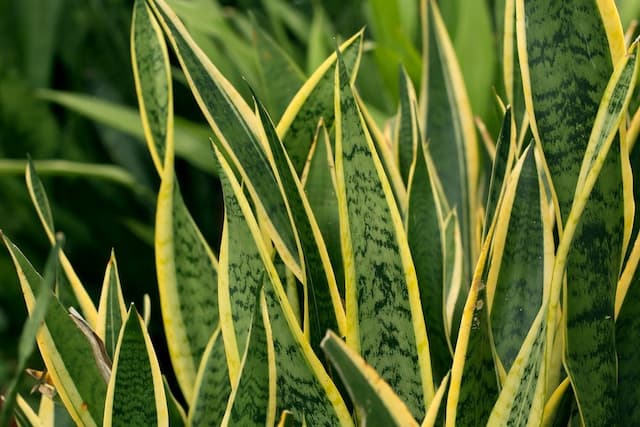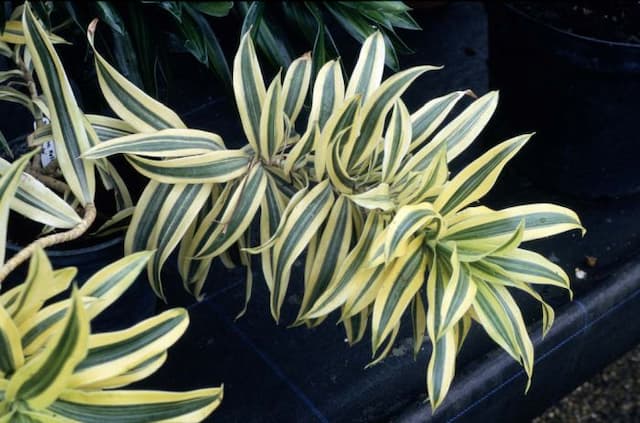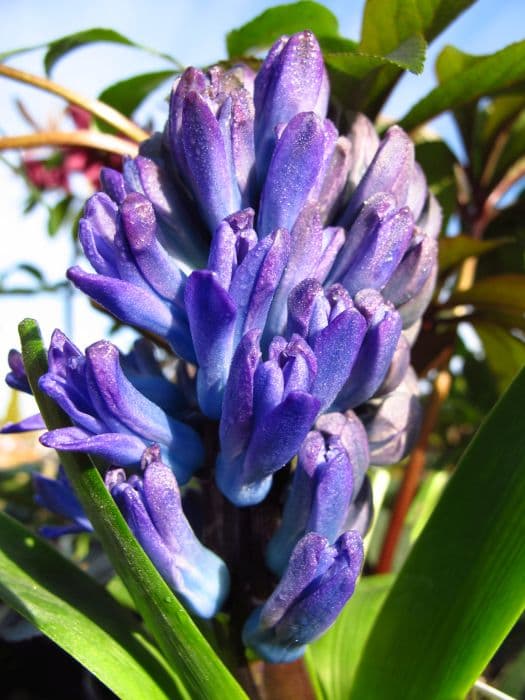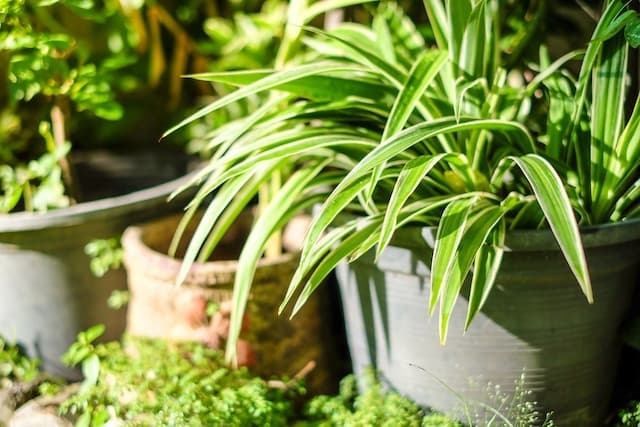Snake Plant Sansevieria trifasciata var. laurentii (v)

ABOUT
The Sansevieria trifasciata var. laurentii, commonly known as the snake plant, is a striking houseplant with a distinctive appearance. The leaves are thick, upright, and sword-shaped, forming dense clusters that grow vertically. Its foliage presents a patterned arrangement of colors with a combination of green and light yellow stripes. The green areas feature darker green horizontal streaks, adding to the plant's textured look. The margins, or outer edges, of each leaf are usually outlined with a creamy yellow to light green border that adds a bold contrast to the deep colors within. The leaves possess a smooth, waxy surface and end in a sharp point. The snake plant's aesthetic is one of architectural rigidity and variegated color that brings a modern and exotic touch to indoor spaces.
About this plant
 Names
NamesFamily
Asparagaceae
Synonyms
Snake Plant, Mother-in-law's Tongue, Saint George's Sword, Viper's Bowstring Hemp, Golden Hahnii
Common names
Sansevieria laurentii, Sansevieria trifasciata 'Laurentii', Sansevieria zeylanica var. laurentii.
 Toxicity
ToxicityTo humans
The Snake Plant, more formally known as Sansevieria trifasciata var. laurentii, has mild toxicity to humans. If any part of the plant is chewed or ingested, it can cause symptoms such as nausea, vomiting, and diarrhea. In some cases, the plant's saponins can cause irritation to the mouth and throat, resulting in swelling and discomfort. The plant is not life-threatening but ingesting it can lead to unpleasant symptoms that may require symptomatic treatment.
To pets
Snake Plant, known scientifically as Sansevieria trifasciata var. laurentii, is toxic to pets such as cats and dogs. Ingesting this plant can cause gastrointestinal upset in pets, including symptoms like nausea, vomiting, and diarrhea. The plant's saponins can also cause excessive drooling, pain in the abdomen, and in some cases, can lead to an allergic dermatitis reaction if the sap contacts the skin. If a pet ingests the Snake Plant, it is advisable to contact a veterinarian as soon as possible to receive guidance on the necessary course of action.
 Characteristics
CharacteristicsLife cycle
Perennials
Foliage type
Evergreen
Color of leaves
Variegated
Flower color
White
Height
2-3 feet (0.6-0.9 meters)
Spread
2-3 feet (0.6-0.9 meters)
Plant type
Succulents
Hardiness zones
9
Native area
West Africa
Benefits
 General Benefits
General Benefits- Low Maintenance: Thrives with minimal care and can survive in various environmental conditions.
- Drought Tolerant: Has succulent-like adaptations that allow it to retain water and withstand periods without moisture.
- Adaptability: Can grow in both low-light conditions and direct sunlight, making it suitable for various indoor placements.
- Decorative: With its striking green leaves and yellow borders, it adds aesthetic value to home and office spaces.
- Growth Habit: Features an upright, structured growth pattern that does not take up excessive horizontal space.
- Longevity: Known for its long lifespan, requiring infrequent replacement or additional care.
 Medical Properties
Medical PropertiesThis plant is not used for medical purposes.
 Air-purifying Qualities
Air-purifying QualitiesThe plant commonly known as Snake Plant is known to improve indoor air quality by: - Removing toxins such as formaldehyde, xylene, toluene, and nitrogen oxides from the air - Producing oxygen, especially at night, through a process called Crassulacean Acid Metabolism (CAM) - Absorbing excessive amounts of carbon dioxide - Filtering indoor air pollutants and allergens
 Other Uses
Other Uses- Sansevieria trifasciata, commonly known as Snake Plant, can be utilized for educational purposes in botany and horticulture to illustrate plant adaptations such as Crassulacean Acid Metabolism (CAM) photosynthesis.
- The strong fibrous leaves of the Snake Plant can be incorporated into textile design classes, demonstrating how plant fibers can be used in weaving or fabric creation.
- Due to its robust and upright growth, Snake Plant can be used in art installations and modern sculptural arrangements as a living element that adds verticality and texture.
- In Feng Shui, the Snake Plant is believed to bring positive energy into a home or office, often used in interior design as a natural element that can influence spatial energy flow.
- The resilient nature of the Snake Plant makes it a study subject for space research, analyzing how it copes with limited resources, which could be useful for long-duration space missions or space farming.
- Snake Plant leaves can be cut into shapes and used as stamps for children's craft projects, providing an eco-friendly alternative to traditional rubber stamps.
- The plant can be used in photography and film sets as a low-maintenance and evergreen prop that does not wilt under hot lights and can be used repeatedly.
- Snake Plants can be used in urban planning and landscaping for green roofing projects, as they are capable of withstanding harsh rooftop conditions and require minimal maintenance.
- Snake Plant leaves can be used as a natural pest deterrent in gardens; their sap can be an irritant to some plant-eating pests.
- In larger installations and exhibitions, the sculptural form of the Snake Plant can guide foot traffic and provide natural barriers without being as imposing as walls or fences.
Interesting Facts
 Feng Shui
Feng ShuiThe Snake Plant is recognized for its ability to purify air and it is said to bring protective and purifying energy into the home according to Feng Shui. It is recommended to place them in areas that would benefit from a greater sense of life or to counterbalance any flowing water elements, as they are thought to have strong Wood energy. Placing it in the southeastern, southern, or eastern corners of a home or room could promote wealth, vitality, and growth.
 Zodiac Sign Compitability
Zodiac Sign CompitabilityThe Snake Plant is not used in astrology practice.
 Plant Symbolism
Plant Symbolism- Longevity: Because of its hardy nature, Sansevieria trifasciata, commonly known as Snake Plant, is often associated with long life and persistence.
- Clean Air: The Snake Plant is believed to filter indoor air, removing toxins and symbolizing health and cleanliness.
- Protection: Its upright, sword-shaped leaves are thought to provide protective energy, warding off negative influences.
- Good Fortune: In some cultures, the Snake Plant is considered a good luck plant, attracting prosperity and fortune.
 Water
WaterTo water a Snake Plant, also known as Sansevieria trifasciata 'Laurentii', allow the soil to dry out between waterings, as they are susceptible to root rot if overwatered. Generally, watering every 2-6 weeks is sufficient, depending on the humidity and light conditions. When you do water, do so thoroughly until water runs through the drainage holes, using approximately 8-16 ounces of water for smaller pots and up to 1.5 gallons for larger containers, though this can vary with pot size and soil composition. It's crucial to empty any water that collects in saucers to prevent the soil from becoming waterlogged.
 Light
LightSnake Plants prefer indirect but steady light with some direct sun. They can adapt to low light conditions but thrive best in bright, indirect sunlight. Ideal placement is near a north-facing window or in a spot that receives filtered light from a southern or eastern exposure. However, be cautious of intense direct sun for extended periods, which can scorch their leaves.
 Temperature
TemperatureSnake Plants are well-suited to a range of temperatures and can survive as low as 50°F, though they prefer a room temperature between 70°F and 90°F. They can withstand temperature spikes above this range but should not be exposed to temperatures below 50°F as this can be detrimental to their health.
 Pruning
PruningPruning a Snake Plant is generally done to remove damaged or old foliage and to maintain its appearance. Using a sharp, clean pair of scissors or pruning shears, snip any brown or wilted leaves at their base. Pruning is best done in the growing season, spring or summer, and should be done as needed rather than on a regular schedule.
 Cleaning
CleaningAs needed
 Soil
SoilSnake plants thrive in a well-draining, sandy soil mix with a pH of around 5.5 to 7.5. A good recipe for Snake Plant is to combine two parts potting soil with one part perlite or coarse sand to enhance drainage.
 Repotting
RepottingSnake plants, also known as Mother-in-Law's Tongue, generally prefer to be slightly root-bound, so repotting every 2-3 years is sufficient, or when the roots begin to crowd the pot.
 Humidity & Misting
Humidity & MistingSnake plants are very tolerant of various humidity levels, but they do best in average room humidity between 30% and 50%.
 Suitable locations
Suitable locationsIndoor
Place in bright, indirect light and water sparingly.
Outdoor
Grow in shade to partial sun; protect from frost.
Hardiness zone
9-11 USDA
 Life cycle
Life cycleSansevieria trifasciata var. laurentii, commonly known as snake plant or mother-in-law's tongue, begins its life cycle as a seed or more commonly by vegetative propagation through division or leaf cuttings. Once planted, the seed or cutting develops roots and shoots, eventually forming sturdy, vertical leaves that are variegated with yellow borders. The plant grows slowly, progressively forming dense clumps by producing rhizomes or stolons that give rise to new shoots. After several years, under appropriate conditions, the snake plant may produce a flower stalk, usually in spring or summer, bearing clusters of greenish-white, fragrant flowers. If pollinated, these flowers can develop into berry-like fruit containing seeds, which can scattered to produce new plants. The snake plant has a long lifespan, with individual plants often living and actively growing for many years with minimal care.
 Propogation
PropogationPropogation time
Spring to Summer
The most popular method of propagating Snake plant (Sansevieria trifasciata var. laurentii), is through division. This can be done at almost any time of year, but the best time is during the spring or early summer months when the plant is actively growing. To propagate by division, carefully remove the plant from its pot and use a sharp, clean knife to separate the rhizome, ensuring that each section has at least one healthy leaf. Replant each section into a new pot filled with a well-draining soil mix, water moderately, and place the pot in a warm area with indirect light. New growth typically appears after a few weeks, indicating successful propagation.









